示踪气体在空腔中扩散的大涡模拟
IF 1.3
4区 工程技术
Q3 MECHANICS
引用次数: 2
摘要
本文利用大涡模拟(LES)对高度(H) 1.0 m、统一长径比的空腔内惰性示踪气体的扩散进行了预测。基于自由流速度和空腔高度计算的流动雷诺数为67 000。空腔上游的气流为层流,形成空腔剪切层,并在空腔上空过渡为湍流。使用三种不同的网格,网格间距分别为H/100(粗),H/200(中)和H/400(细)。在每个网格上使用Smagorinsky、WALE和Germano-Lilly亚网格尺度模型来量化亚网格尺度模型对模拟流的影响。网格的粗化导致预测速度场的微小变化,并导致对示踪气体浓度统计数据的大量过度预测。对示踪气体统计数据的定量度量分析表明,粗网格模拟产生的结果超出可接受的公差范围,而中间网格和细网格模拟产生的输出可接受。对每个模拟中存在的流体动力学分析表明,空腔剪切层的演变受到网格和亚网格尺度模型的严重影响。在粗网格和中间网格上,剪切层的发育被延迟,抑制了示踪气体进入剪切层的夹带和混合,减少了示踪气体从空腔中的去除。在细网格上,剪切层的发展更为迅速,从而增强了对空腔中示踪气体的去除。浓度概率密度函数表明,细网格模拟准确地预测了示踪气体对空腔两壁的浓度范围和最可能值。本文的结果表明,WALE和Germano-Lilly模型在模拟城市环境中污染物扩散方面可能优于标准Smagorinsky模型。本文章由计算机程序翻译,如有差异,请以英文原文为准。
Large Eddy simulation of tracer gas dispersion in a cavity
This paper assesses the prediction of inert tracer gas dispersion within a cavity of height (H) 1.0 m, and unity aspect ratio, using large Eddy simulation (LES). The flow Reynolds number was 67 000, based on the freestream velocity and cavity height. The flow upstream of the cavity was laminar, producing a cavity shear layer which underwent a transition to turbulence over the cavity. Three distinct meshes are used, with grid spacings of H/100 (coarse), H/200 (intermediate), and H/400 (fine) respectively. The Smagorinsky, WALE, and Germano-Lilly subgrid-scale models are used on each grid to quantify the effects of subgrid-scale modelling on the simulated flow. Coarsening the grid led to small changes in the predicted velocity field, and to substantial over-prediction of the tracer gas concentration statistics. Quantitative metric analysis of the tracer gas statistics showed that the coarse grid simulations yielded results outside of acceptable tolerances, while the intermediate and fine grids produced acceptable output. Interrogation of the fluid dynamics present in each simulation showed that the evolution of the cavity shear layer is heavily influenced by the grid and subgrid scale model. On the coarse and intermediate grids the development of the shear layer is delayed, inhibiting the entrainment and mixing of the tracer gas into the shear layer, reducing the removal of the tracer gas from the cavity. On the fine grid, the shear layer developed more rapidly, resulting in enhanced removal of the tracer gas from the cavity. Concentration probability density functions showed that the fine grid simulations accurately predicted the range, and the most probable value, of the tracer gas concentration towards both walls of the cavity. The results presented in this paper show that the WALE and Germano-Lilly models may be advantageous over the standard Smagorinsky model for simulations of pollutant dispersion in the urban environment.
求助全文
通过发布文献求助,成功后即可免费获取论文全文。
去求助
来源期刊

Fluid Dynamics Research
物理-力学
CiteScore
2.90
自引率
6.70%
发文量
37
审稿时长
5 months
期刊介绍:
Fluid Dynamics Research publishes original and creative works in all fields of fluid dynamics. The scope includes theoretical, numerical and experimental studies that contribute to the fundamental understanding and/or application of fluid phenomena.
 求助内容:
求助内容: 应助结果提醒方式:
应助结果提醒方式:


